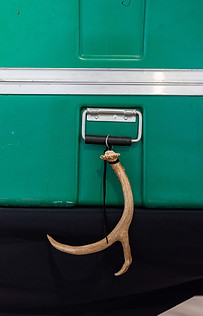top of page
2023
Laurie Steelink
HEALING HERE, HERE HEALING, 2023
Mixed media installation
Part luggage rack, staging surface, and market table HEALING HERE, HERE HEALING, is an assortment of pieces reflective of the artist’s practice and healing journey, encompassing intentions for the healing of Native Peoples. Steelink says of the work, “my community has a long history with problematic substance use and it is deserving of attention so that we may heal from it.” The sacred Medicine Wheel is depicted on a found object once used by the Divers Alert Network which contained lifesaving medical equipment. Medicine Wheels (hoop) represent the never-ending cycle of life. The hoop has no beginning and no end, like the snake eating its tail. The wheel represents the alignment and the continuous interaction of the physical, emotional, mental, and spiritual realities. The circle shape represents the interconnectivity of all aspects of one’s being, including the connection with the natural world.
This piece was included in the exhibition RED EARTH GAZE, curated by Gloria Gem Sánchez. October 12–December 9, 2023
Angels Gate Cultural Center, Gabrielino-Tongva homelands, San Pedro, California
Photography by Jordan Rodriguez










LAURIE STEELINK
Spirit is Alive, Magic is Afoot
Exploring connections to her Native American roots, artist and curator Laurie Steelink creates assemblages of found objects and reassembled paintings to question authenticity and consider spirituality. This exhibition features mixed-media assemblages and sculptures, photographs, installations, and a video by Steelink, alongside traditional weavings and beadwork by Victoria Ferguson, director and docent for the Solitude-Fraction site in Virginia Tech’s Office for Inclusion and Diversity.
A citizen of the Akimel O’otham Nation and a member of the Gila River Indian Community, Steelink draws inspiration from her upbringing amidst the resilient Saguaro cacti of Arizona. Her works often feature these towering symbols of survival, reflecting their ability to weather harsh conditions and nurture desert life. Steelink gathers her assemblages and paintings in constructed market booths modeled on the traditional specifications of Indian market booths in which the artist has participated. The market booth presentation possesses intentional irony–being crafted by a genuine Native artist, Steelink questions perceptions of authenticity while exploring her heritage.
VICTORIA FERGUSON
As a curator, Laurie Steelink is dedicating a section in her exhibition to the work of Monacan Nation citizen Victoria Ferguson to honor the People’s heritage and land on which Virginia Tech resides. The Sherwood Payne Quillen ’71 Reception Gallery showcases Ferguson’s clothing, pottery, rattles, and grass mat pieces made from natural materials. Ferguson’s handcrafted functional objects reflect both the practical and the artistic facets of regional Indigenous craft/art. Cattails, an exceedingly significant plant with many uses in regional Indigenous technology, frame Ferguson’s work. The silhouetted renderings of cattails on the walls reflect the Indigenous practice of harmonizing with nature. Like Steelink’s use of the Saguaro cactus, the cattails intertwine physically and socially and are understood as valuable members of the community.
With over two decades of dedicated research, Ferguson, a citizen of the Monacan Nation of Virginia and a Virginia Tech scholar, has uncovered first-person documentation and archaeological information to reveal the daily lives of Eastern Siouan populations through the early European colonization period. Ferguson’s work explores sustainable food systems, Indigenous technologies, and the resilience of traditional knowledge in the region.
Photography by Pippi Miller









bottom of page